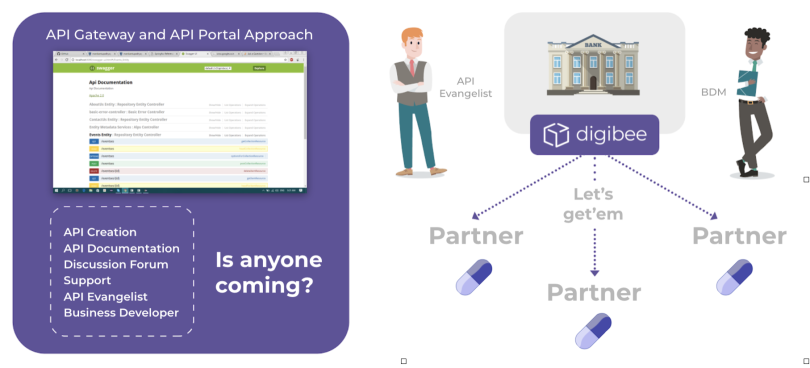A developer portal provides the necessary technical information to configure and manage communication between an API and both internal and external systems.
However, they were not originally thought of as a business-generating tool for companies that adopted them.
All developer portal elements cause friction for partners and lead to higher costs for the company providing data through APIs. To eliminate this animosity, companies need simple system connection solutions that generate more business through pairing their ecosystems more directly, more efficiently and at a lower cost.
The use of a hybrid integration platform (HIP) helps to increase the revenue stream by reducing the conflict that integration might cause.
Fixing Inherent Problems With a Developer Portal
The most common cause of friction is the amount of time it takes to create and support a developer portal. Quite often, an integration experiences delays because the company providing the API gets stuck waiting for support from the people they are working with.
Companies that provide APIs later understand that they must provide more data, new business cases and different mappings and transformations in order to fulfill the demands of consumers in different stages of maturity.
Once the portal and APIs are adapted to the system, the following three key factors must be delivered to provide a good user experience in the developer portal:
- Complete and easy-to-use documentation.
- Actionable and effective solution options.
- Quick response time.
Isolated and disconnected business challenges can complicate developer portal implementations. To avoid such challenges, you should address these questions before the implementation takes place:
- How can you ensure the business will benefit from the connection with partners, suppliers and customers?
- Is it possible to become more efficient, have lower integration costs and improve implementation and adoption times for technological solutions?
- How is innovation unlocked when previously unavailable data and services are made internally available?
When approaching a systems integration, it is essential to deliver a solution that considers the business results first — before removing or simplifying any technical issues. Fixing predicted issues before they become problems only wastes time and takes the focus off the goal of making your business more efficient and profitable.
We often see this in practice: Businesses tend to spend too much time fixing problems before they even occur. To create an efficient system, its value proposition must include the addition of new integration solutions (based on hybrid integration platforms) that drastically reduce adoption complications, improve the user experience and minimize technical complexity, while increasing security.
To better understand these challenges, we must understand why they happen.
Are Open APIs Effective Enough When Using a Developer Portal?
To answer this question, we must analyze the total cost to take the traditional approach of generating a developer portal. Here are some things to consider:
- Cost and labor to create education material for the APIs’ business propositions and the effort to create technical material about APIs.
- Procedures to make APIs with accessible test mechanisms.
- Making calls in the different available languages — some of which will not necessarily be used.
- Time to develop SDKs in different languages and maintain compatibility.
- The need to hire an evangelist and business developer to support the real people behind the search for API-based solutions.
- And the ability to support everything.
Creating a developer portal depends on whether the evangelist and business developer can prove that the use case is worth the investment, despite the fact that the portal might not be used in the way it was initially intended. For example, imagine a bank wants to create APIs to provide loans. The APIs must pass all steps mentioned above to feed the developer portal.
Once all the documentation is produced, the APIs are set up and the test environment is configured, the bank needs to recruit developers and partner companies to create a solution for the APIs. Furthermore, the bank’s business developer must find customers to use the APIs.
Once bank customers enroll in the developer portal and explore the APIs, documentation and the code to build the integrations, they must then decipher how those APIs will connect with their internal systems such as ERP, CRM and EDI.
HIPs Reduce Friction
An HIP allows users to develop, secure and govern integration flows that connect diverse applications, systems, services and data stores. It also enables rapid API creation, composition and lifecycle management to meet the requirements of a wide-range of diverse integration use cases.
A modern HIP offers a visual and intuitive interface based on low-code concepts, which abstract away the integration complexity with ready-to-use components that implement business cases — thus reducing the effort to accomplish such integration tasks.
An HIP also needs modern architecture to scale, covering and replacing the main features of traditional integration landscapes like message queues, service brokers, file management and more. It serves as an accelerator so that development teams can focus on what is most important to them: their business demands.
With an HIP, you can create a point-to-point integration system with security and data integrity, while accelerating solutions development.
How to Accelerate Your Time to Market — While Increasing Your Revenue Stream
At Digibee, we’re focused on solving this challenge. With our HIP, users have:
- A connection with numerous market systems.
- Simple and fast data transformation.
- Reuse, standards and documentation.
- End-to-end security integration.
- Real-time view of integration adoption by the business stakeholders.
- Support and monitoring during the term of the contract with no limits.
- No additional costs to configure the integrations.
Specialized, best-in-class architectural practices.Through our HIP, there are reusable encapsulated business cases, which we called Digibee Capsules. For example, if you supply loans for students, once the concept, logic and code of delivering the loan are packaged, the Capsules can be reused by any other education groups that use an ERP.
Additionally, Capsules can be offered in Marketplaces —not of APIs, but of ready-to-use business cases, which are created by Digibee and its customers and partners. This way, customers can add traction to their business.

API evangelists are in charge of promoting and supporting the use of APIs by partners. With the Capsule approach, evangelists take on a new role, giving partners the opportunity to create new Capsules in real-time. For example, a developer can discuss business cases while creating Capsules directly in the Digibee platform.
Partners who have a sandbox testing environment are able to simulate and create Capsules to accelerate any kind of business. For instance, if a university wants to provide credit for students to pay tuition using a bank, and the university has an ERP, Digibee provides the connection between the Capsule, the bank and the ERP, using logic and built-in security that has already been tested and approved.
Our goal at Digibee is not to simply eliminate the access point of APIs, but to provide a marketplace of ready-to-use cases. Instead of one open API, Digibee brings a broader, end-to-end view that considers the global ecosystem that will require systems integration in a standard yet cumbersome way.
Digibee implements a “simplexity” mindset — an emerging theory that proposes a possible complementary relationship between complexity and simplicity. For Digibee, simplexity is how it manages complex integration challenges with a simple approach, using this mindset that consists of:
- Digibee’s native cloud platform.
- Hundreds of connectors ready to link directly to endpoints.
- Ready-to-use Capsules.
- Turnkey integrations.
- 24/7 monitoring and support of integrations (in our SaaS or in your cloud).
- Architecture guidance and training with field experience and best practices.
- Differentiated business models to use — not to buy or build.
- Empowerment of business-led IT to fulfill their digital projects.
Digibee enables businesses to change the way they interact with partners, customers and revenue streams — while decreasing the disunity between developers, APIs, architecture, integrations and potential deals.
The Digibee HIP is a future-proof structure to engage business ecosystems with cloud-scale, ready-to-use processes, business cases and security. It’s our view that — by implementing our Capsule approach and simplexity mindset — there is a path to provide innovation against the current developer portal and API models.





